GENERALIZED COORDINATES AND LAGRANGE’S EQUATIONS
In deriving the equations of motion for many problems in aeroelasticity, generalized coordinates and Lagrange’s equations are often used. The ideas of generalized coordinates are developed in the classical mechanics, and are associated with the great names of Bernoulli, Euler, d’Alembert, Lagrange, Hamilton, Jacobi, and others. There are many excellent textbooks on this subject,1-54,1-68,1-69 and so we shall not explain the method in great detail. Instead, we shall survey the fundamental principles briefly, and illustrate their meaning by several examples.
The foundation of the mechanics of a single particle is Newton’s second taw of motion where F is the total force acting on the particle, and p is the linear momentum of the particle defined by the product of mass m and velocity v:
![]() p — mv
p — mv
In applying this law to a system of N particles, we must distinguish between the external forces acting on the particles due to sources outside the system and internal forces on a particle і due to all other particles in the system. Thus the equation of motion for the zth particle is[4]
where F;,e) is the external force, Ftf is the internal force on the ith particle due to the jth particle, and p£ is dpjdt. If we assume that F„ (like Ft(e))
obeys Newton’s third law that the forces the two particles exert on each other are equal and opposite and lie along the line joining the particles, then by a summation over all the particles we can show that (a) the center of mass moves as if the total external forces were acting on the entire mass of the system concentrated at the center of mass, (b) the time derivative of the total angular momentum about an origin is equal to the moment of the external force about the same point, (c) the total angular momentum about a fixed point О is the angular momentum about О of the system concentrated at the center of mass, plus the angular momentum about the center of mass, (d) the kinetic energy, like the angular momentum, also consists of two parts: the kinetic energy obtained as if all the mass were concentrated at the centre of mass, plus the kinetic energy of motion about the center of mass.
The problems in mechanics would have been reduced to solving the set of differential equations 3 if no constraints which limit the motion of the system were present. But constraints do occur. For example, the distance between any two particles in a rigid body remains unchanged; the root of a cantilever wing is restrained against relative motion with respect to the clamping wall; the aileron must remain attached at the hinge; the fuel must move only inside of the container. Two difficulties are introduced by the constraints. First, the coordinates of the particles, r, (/’ = 1, 2, • ■ •, N), are no longer all independent, since they are connected by the equations of constraint. Second, the forces of constraint, e. g., the forces exerted by the clamping wall of a cantilever beam, are not known a priori; they are among the unknowns of the problem and in many cases are of no direct interest. To overcome these difficulties, the problems of mechanics may be formulated in terms of independent coordinates and in a form in which the forces of constraint do not appear. This is the purpose of the Lagrangian formulation in terms of generalized coordinates.
Constraints may be classified as follows: If the conditions of constraint can be expressed as equations connecting the coordinates of the particles and the time, having the form
Ж, r2, r3, • • •, 0 = 0 (4)
then the constraints are said to be holonomic. Otherwise they are non – holonomic. The constraints of the particles in a rigid body are holonomic, because they can be expressed as
(r, – r3)2 – cu2 = 0
The walls of fuel tank limiting the motion of fuel molecules are non – holonomic because the constraint cannot be written in the form of Eq. 4.
When the constraints are holonomic, a number of coordinates can be eliminated. In terms of Cartesian coordinates, a system of N particles, free from constraints, has 3N independent coordinates or degrees of freedom. If there exist holonomic constraints expressed in к equations, we may use these equations to eliminate к of the 3N coordinates, and we are left with 3N — к independent coordinates, and the system js said to have 3N — к degrees of freedom. This elimination of the dependent coordinates can be expressed in another way, by introducing 3N — к new independent variables qx, q2, • • •, qSN„k, in terms of which the old coordinates rls r2, • • >, iN are expressed by equations of the form
ri = rl(?l> ’ ’ ’> 0
(5)
rJV — rw(?l* ?2> ‘ ‘ ’> Чзя-ь 0
containing the constraints in them implicitly. These are equations of transformation connecting the set of variables (r,) with the new variables (<7г) which are all independent.
By transformation of variables from r, to qt, it can be shown (see Ref. 1.54,1.56,1.68, or 1.69) that the equations of motion 3 can be transformed into the form
where n is the number of degrees of freedom of the system. T is the kinetic energy, which is one half of the sum of the mass times velocity squared of all the particles of the system. When the velocity of each particle is expressed in terms of the rate of change of the independent coordinates qt, T can be expressed in the form
The constant coefficients M{j are called the generalized masses. In Eq. 6, Qi (j = 1,2,* • ■, ri) are the components of the generalizedforce defined as
where F, is the force applied on the /th particle. Note that the virtual
work done by the forces through virtual displacements <5rt- (or the corresponding dq}) is
Often it is more convenient to calculate the generalized force Qt by Eq. 7. Note also that just as the q’s need not have the dimensions of length, so the O’s do not necessarily have the dimensions of force; but 0,(5^- must always have the dimensions of work.
It may not be superfluous to remark that a (infinitesimal) virtual displacement of a system refers to a change in the configuration of the system as the result of any arbitrary infinitesimal change of the coordinates <5rt – or dqit which obeys the constraints imposed on the system at the given instant t. It is called “virtual” in order to be distinguished from an actual displacement of the system occurring in a time interval dt. By means of a virtual displacement, we can compare the kinetic energy of a system with that of a “neighboring” system which differs only infinitesimally from the actual one, yet not obeying the laws of motion. The Lagrange equations of motion can be deduced from such a comparison.
When the generalized force can be derived from a scalar potential so that
dV
Qi = — -— (conservative system) (8)
Eq. 6 can be written as
d /ЗП _ 3(7′ — V) = 0 dt dfaj dqs
The potential V is a function of position only, and must be independent of the generalized velocities fa. Hence, one can include a term V in the partial derivative with respect to fa:
![]() £ /Э(Г – F) _ Э(Г – V) = o dt dfa / bq}
£ /Э(Г – F) _ Э(Г – V) = o dt dfa / bq}
Or, if we define a new function, the Lagrangian L, as
L = T — V
then
d (3L ЪЬ л,
— = 0 (conservative systems)
Equations 11 are usually called Lagrange’s equations. In aeroelasticity, the forces derived from the elastic deformation are conservative, and their
potential can be identified with the strain-energy function. The aerodynamic forces, on the contrary, cannot be derived from a potential. Hence, we must retain the general equation 6. In general, we may write the equations of motion as
where Qj represents that part of the generalized forces that are not derived from a potential, and L contains the potential of the conservative forces as before.
 |
Example 1. A Weightless Beam with a Concentrated Mass at the Midspan. Consider a weightless beam with a concentrated mass at the mid
span (Fig. 1.14). A force P(t) acts on the mass. The geometrical configuration is determined completely by the displacement у of the mass m. Here
V = Ky Q — P(t)
where V is the strain energy. Substituting into Lagrange’s equation,
we obtain the equation of motion
my + Ky= P(t)
Example 2. A Weightless Cantilever Beam with a Mass, that Has a Finite Moment of Inertia, Attached at the Free End (Fig. 1.15). Let us take the displacement of m as qlt and the rotation of the mass moment of inertia /as q2-, then
T=mqf + lqf V = lKuqf + tKnqf + KM
where K{j are the stiffness-influence coefficients. Hence, from Lagrange’s equations, we obtain
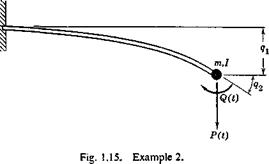 |
Щі + Kn<h + Ki2% = p + Kn4i + кііЧі — Q
 |
Example 3. An Airplane Idealized into a Weightless Elastic Beam Connecting a Number of Concentrated Masses and Moments of Inertia. Let us take the displacements of the masses and the rotations of the inertias as the generalized coordinates (as shown in Fig. 1.16). Then
ip ip
v = 2 2 (strain energy)
І=1 j—l
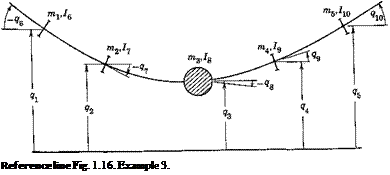 |
L = T — V
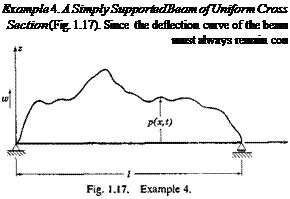 |
The equations of motion can be obtained from Lagrange’s equation. If the gravitational force need be considered, the gravitational potential should be added to V.
tinuous, it can be developed in a Fourier series. Thus the deflection w can be written as
CO
|
2 |
. П7ТХ
ansm —
71 = 1
The configuration of the beam is completely determined by the Fourier coefficients aw Hence, an may be taken as the generalized coordinates: q. = at (і = 1, 2, 3, • • •)
When the beam vibrates, w and hence q{ = a, are functions of time.
The strain energy is given by
dx
If there is a system of lateral loads acting on the beam, the generalized forces can be calculated as follows: Let the generalized coordinate an be given a virtual displacement dan. The beam configuration undergoes a virtual displacement 6w(x) = dan sin (mrx/l). The work done by the external loads p(x, t), the positive sense of which is defined as the same as that of w, is
![]() Qn <4, =jo pi*, 0 bw(x) dx = £ p(x,
Qn <4, =jo pi*, 0 bw(x) dx = £ p(x,
But 6an is arbitrary; hence,
[l. mrx
Qn = Jo P(x> t) sm — dx
The equations of motion can then be written down according to Lagrange’s equation:
d /Щ dV dtdaj+dan Qn
i. e.,
T &n + "4a" =Jo p(~X’ ^ sin ~fdx (И = 1, 2, 3, • • •)
Example 5. A Cantilever Beam of Uniform Cross Section. The deflection of the beam can be expanded into a series
CO
w(x, t) =^qn(t)fn(x)
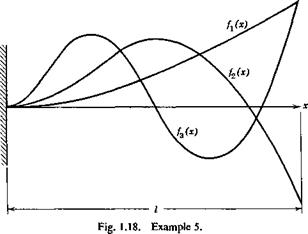 |
П — 1
where f„(x) is the nth mode of the undamped free vibration of the beam (Fig. 1.18). The functions fjx) are orthogonal and can be normalized so that
|
/,(*) Ux) dx |
![]()
 when v = n, when v Ф n. in Ex. 4, we have
when v = n, when v Ф n. in Ex. 4, we have
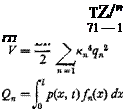
г
where кп are the solutions of the equation cos кі – cosh к-/ + 1 = 0. Therefore, under a lateral load p(x, t) the equations of motion are
mlqn + ЕПкп% = f p(x, t)fn(x) dx Jo











